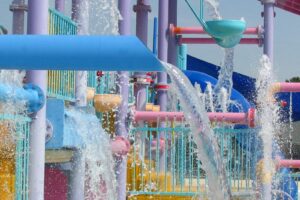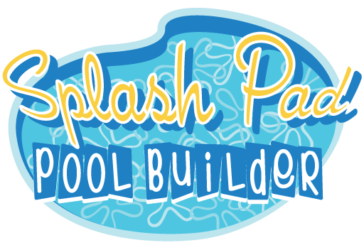Creating a splash pad at home is a fantastic way to enhance your backyard, offering endless fun for children and a refreshing space for adults. In this guide, we’ll cover everything you need to know about home splash pads, from design tips provided by pool builders to the benefits of custom splash pads.

Why Choose a Home Splash Pad?
A home splash pad is a versatile water feature that provides a safe and fun environment for kids to play in. Unlike traditional pools, splash pads have a shallow water level, reducing the risk of drowning. Additionally, they are easier to maintain and can be designed to fit any backyard size or shape.
Benefits of Installing a Custom Splash Pad
- Safety: With no standing water, splash pads are a safer alternative to pools, especially for young children.
- Low Maintenance: Splash pads require less maintenance compared to traditional pools. There’s no need for lifeguards, and the water is typically treated and recycled, reducing water usage.
- Customization: Home splash pads can be customized to fit your specific needs and preferences. Whether you want a themed design or a simple layout, a pool builder can help you create the perfect splash pad.
- Year-Round Use: Many splash pads can be used year-round, depending on your location and the design of your splash pad.
Design Tips from Expert Pool Builders
To create a perfect splash pad, consider these expert tips:
- Planning the Layout: Start by planning the layout of your splash pad. Determine the available space in your backyard and how you want to incorporate the splash pad into your landscape. Consider adding features like slides, water jets, and interactive water toys.
- Choosing Materials: Select durable and non-slip materials for the splash pad surface. This ensures safety and longevity. Common materials include concrete, rubber, and textured tiles.
- Water Management System: Work with a pool builder to design an efficient water management system. This includes pumps, filters, and drainage systems to keep the water clean and safe.
- Customization Options: Think about the customization options available. A custom splash pad can include unique features like themed elements, colorful lighting, and varying water pressures for different effects.
- Safety Features: Ensure that the splash pad design includes safety features such as proper drainage, non-slip surfaces, and no sharp edges. Consulting with a professional pool builder can help you incorporate these elements effectively.
Steps to Install Home Splash Pad
- Consultation with a Pool Builder: Begin by consulting with a reputable pool builder who has experience in creating splash pads. They will help you design a splash pad that meets your needs and budget.
- Design Approval: Once you have a design, review and approve it. Make sure it includes all the features you want and adheres to safety standards.
- Construction: The construction phase involves preparing the site, installing the plumbing and water management system, and building the splash pad surface. This step should be handled by professionals to ensure quality and safety.
- Testing and Final Touches: After construction, the splash pad will undergo testing to ensure everything works correctly. Any final touches, such as adding water toys or landscaping around the splash pad, will be completed.
- Enjoying Your Splash Pad: Once the splash pad is installed and tested, it’s ready for use. Regular maintenance will keep it in good condition for years to come.
Maintaining Your Splash Pad
Maintenance is crucial to ensure the longevity and safety of your splash pad. Here are some maintenance tips:
- Regular Cleaning: Clean the splash pad surface regularly to prevent mold and mildew. Use appropriate cleaning solutions that are safe for the materials used.
- Check the Water System: Regularly inspect the water management system, including pumps and filters. Ensure that they are functioning correctly and clean or replace filters as needed.
- Winterizing: If you live in an area with cold winters, winterize your splash pad to prevent damage from freezing temperatures. This involves draining the water system and covering the splash pad.
- Professional Inspections: Schedule annual inspections with a pool builder to check for any issues and ensure your splash pad remains safe and functional.
Wrapping Up with a Splash!
A home splash pad is an excellent addition to any backyard, offering fun, safety, and customization options that traditional pools may not provide. By following the tips from expert pool builders and maintaining your splash pad properly, you can enjoy this fantastic water feature for years to come.
Whether you’re looking for a custom splash pad or need advice on design and installation, consulting with a professional pool builder can make the process seamless and enjoyable. Start planning your home splash pad today and transform your backyard into a refreshing oasis.
